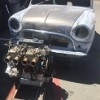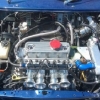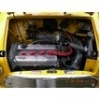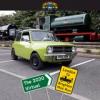As an ex-de Havilland student apprentice, the Mosquito is very dear to my heart. In fact it was the first multi-role combat aircraft in the truest sense, as it was not a basic type which was adapted to do other roles not particularly well, it was a success in every role it undertook. It was, quite simply, superb and represented de Havilland's original thinking in all things aeronautical. The Germans hated it whilst Hermann Goering was just envious!
I couldn't agree more, I'm envious of you working for them, what a great aircraft. I know this has drifted from the OP's original post but I thought I would just put down a couple of memories. I first became aware of the Mosquito during a summer job while at Uni in the 1970's. I got some work with a joiner (who was a very quiet man) but over the course of a couple of summers he became a little more talkative.
It turned out during the war he had been a navigator, initially in Lancasters and then progressed to the Mosquito as part of the pathfinder force and eventually being Master Bomber 17 times. He explained in a manner that only a face to face discussion can convey the fear they went through night after night. At one point they went back to the same target three consecutive nights knowing the enemy would be waiting for them. Brave guys indeed; it makes me smile when a commentator says a footballer is brave when he walks up to take a penalty.
He flew out of Downham Market and went back many years after the war for the dedication of a small memorial at the former airfield, while he was there, he went round some of the old buildings that were still standing and found some small discarded items. Some of the ones he showed me were a collection of what looked like melted tubes; it turned out to be the exhaust stubs off the Merlin engines. Apparently after they had dropped their bomb load they opened the throttles as far as possible and set off for home as quickly as possible but because they were attacking targets so far from home they were very often marginal on fuel, therefore, to gain the maximum range they leaned off the mixture and this caused the engines to run much hotter and therefore burn the ends off the exhaust stubs. This had the consequence of highlighting their position due to the exhaust flames being exposed to the night sky making them an easier prey for marauding night fighters. Their only saving grace was the Mossie was such a fast beautiful handling aircraft the trade off was worth it because he lived to tell the tale.
What was surprising was it was an offence to knowingly damage government property i.e. burning exhaust stubs off, so the ground crew had to replace them saying they were battle damage.
Being built of wood meant it could withstand a lot of flack damage and still get home but the wooden construction did have a downside. After the war a couple of squadrons were sold to air-forces in the middle east and he went out as part of the familiarisation crew, unfortunately, they started experiencing structural failure during flight. What no one had realised was the intense heat over there was un-bonding the glue and they were literally falling apart. They were so unsafe they had to be left out there, I wonder what happened to them.
I know this has drifted from the original post and if the moderators don't think it appropriate then remove it.




















